#NASA footage of surface Mars
Text
NASA के Ingenuity हेलीकॉप्टर ने मंगल पर भरी 25वीं उड़ान, देखें दूसरी दुनिया का अद्भुत नजारा!
NASA के Ingenuity हेलीकॉप्टर ने मंगल पर भरी 25वीं उड़ान, देखें दूसरी दुनिया का अद्भुत नजारा!
If you’re also interested in seeing another world, take heart! NASA’s Ingenuity helicopter has created another feat of flying on Mars and has sent the footage to the Earthlings. This was the 25th flight of the Ingenuity helicopter to Mars. NASA has released its video. NASA has said that this was the longest and fastest flight of the helicopter so far.
On April 18, NASA’s Mars Helicopter Ingenuity…
View On WordPress
#flight on mars#flight to mars#how is the surface of mars#ingenuity#ingenuity helicopter#ingenuity helicopter nasa#ingenuity mars helicopter#mars flight#mars surface video#mars video footage#nasa#NASA&039;s Mars Helicopter#NASA&039;s Mars Mission
0 notes
Text
What is your favourite Doctor Who story?

ROUND 1 MASTERPOST
synopses and propaganda under the cut
Listen
Synopsis
The Doctor has been pondering a question: have people ever been truly alone? Does something lurk unseen beside us all? With Clara at his side, the Time Lord will find himself delving into familiar pasts and eerie futures. Just where does the answer to the old man's unanswerable question lie? Will he find the answers he's been searching for, or will his quest cost him his life this time?
Propaganda no propaganda submitted
The Girl Who Died
Synopsis
After an adventure and a half in space, the Doctor and Clara are kidnapped by 9th-century Vikings. However, to make matters worse, hostile aliens have also arrived in the vikings' village; they are provoked into declaring war on the village by a stubborn girl.
By the end of the adventure, the Doctor will learn where it was that he saw his own face before, and the reason why he chose it.
Propaganda no propaganda submitted
Sleep No More
Synopsis
The Le Verrier space station fell silent only a day ago. No-one really knows what happened. However, some footage of the attempted rescue mission was found. The station appears empty, except for two nosy time travellers: the Doctor and Clara.
Propaganda no propaganda submitted
Knock Knock
Synopsis
Bill and her friends rent an old house to live in, but the floorboards and the walls are creaking, and there's a creepy Landlord lurking around. Can the Twelfth Doctor save the day as creatures come crawling out of the wood?
Propaganda no propaganda submitted
The Lie of the Land
Synopsis
The Monks have ruled the world since humanity took its very first baby steps towards the Sun. One problem... they haven't always been there. And only Bill Potts sees the truth. But where is the Doctor? And how can Bill make the rest of the world see?
Propaganda no propaganda submitted
The Empress of Mars
Synopsis
When NASA discovers a message reading GOD SAVE THE QUEEN under the ice on Mars's surface, the Twelfth Doctor, Nardole, and Bill travel to the Red Planet to investigate. On arrival, they find Victorian soldiers embroiled in a conflict with one of Mars’s ancient species.
Propaganda no propaganda submitted
19 notes
·
View notes
Text
OPPY DAYS
Opening in theaters this weekend; on Prime Video November 23...

Robots have been a mainstay in movies for most of the past century, and one of the recurrent themes of such tales is the question of whether they are conscious entities, with personality and agency. Good Night Oppy is the first film I know of on this subject that isn't science fiction.
This documentary chronicles the careers of Opportunity and Spirit, two robotic Mars Rovers launched by NASA in 2003 to explore the Martian surface in search of evidence that there was once water, and thus possibly life, on the Red Planet. The project followed a couple of embarrassing and expensive NASA failures, the Mars Polar Lander and the Mars Climate Orbiter in 1998, both of which were ignominiously lost, in one mortifying case through human error caused by confusion between American measurement and the metric system.
Spirit and Opportunity, by contrast, were overachievers. Brilliantly designed and engineered, both remained operational for many years longer than their projected mission duration of 90 "sols" (Martian days) and added greatly to human understanding of Martian geology and natural history.
But impressive and interesting as their discoveries were, this isn't really what Good Night Oppy is about. The dramatic core of the film is about the degree to which the scientists and engineers who built the robots, and who supervised their activities from the Mission Control at the Jet Propulsion Lab in Pasadena, California, anthropomorphized their creations, attributed personalities to them, worried and fretted about them and ultimately mourned them.
Directed by Ryan White and gravely narrated by Angela Bassett, the film alternates convincing simulations of the endearing robots on the Martian surface, created at Industrial Light & Magic, with actual footage of their controllers monitoring and guiding them back at JPL. We watch the beautiful nerds age with them, frowning at their struggles and grinning at their triumphs like soccer moms.
One of the designers notes that the robot he worked on was "just a box of wires" but admits that she took on a human persona for him. Another notes that the supposedly identical rovers had distinct personalities; that Spirit was "troublesome" while Opportunity was "Little Miss Perfect." One of the project leaders says that to compare their relationship to parenting would be to "trivialize parenthood," but there's no doubt that the relationship these people feel toward Spirit and "Oppy" is parental.
There was something highly satisfying about watching a bunch of top-flight scientific minds enter matter-of-factly into thoroughly sentimental projection. After a while it's hard not to wonder if it is projection, or perhaps a sensitivity to the beginnings of a rudimentary sentience; to wonder if, at some level, human beings are not ourselves just boxes of wires that somehow attained self-awareness.
It should be noted that the filmmakers do nothing to discourage this idea; they don't explain, for instance, that the rather Harold-Pinter-ish plainsong sentences from the rovers were human translations of transmitted data, not verbatim statements. Even so, the effect of the film was, for me, not only thought-provoking but deeply emotional.
The soundtrack is also worth mentioning; it draws on the wake-up songs that were played at Mission Control at the beginning of the robot's shifts. Selections range from "Roam" by the B-52s to "S.O.S." by ABBA, and they all seem to take on deeper meanings in context. It would make a pretty good mix-tape album.
#good night oppy#nasa#ryan white#angela bassett#industrial light and magic#mars#mars rover#jet propulsion laboratory
45 notes
·
View notes
Photo
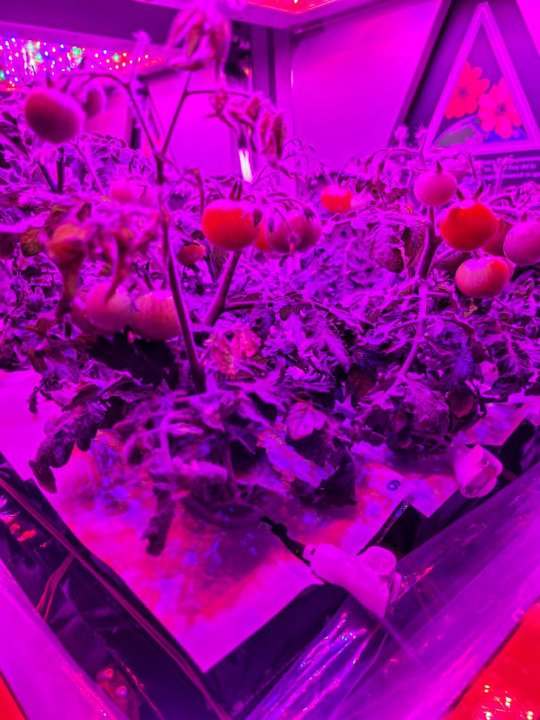
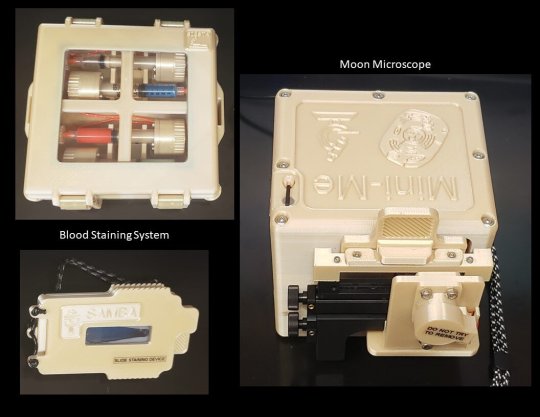
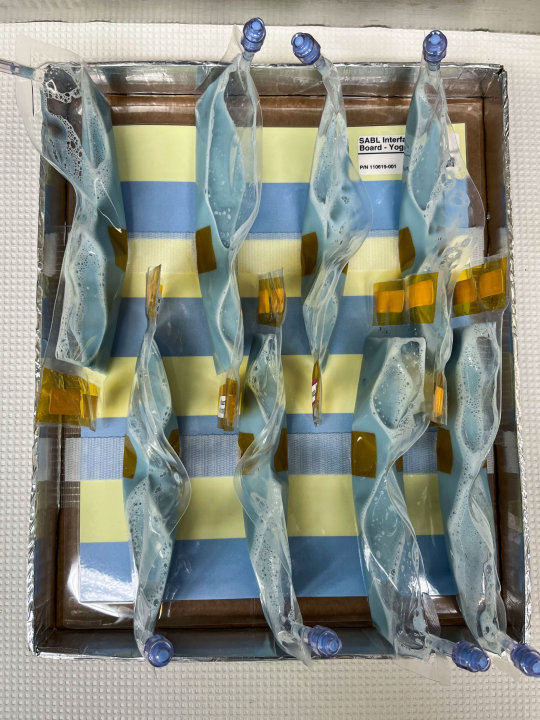
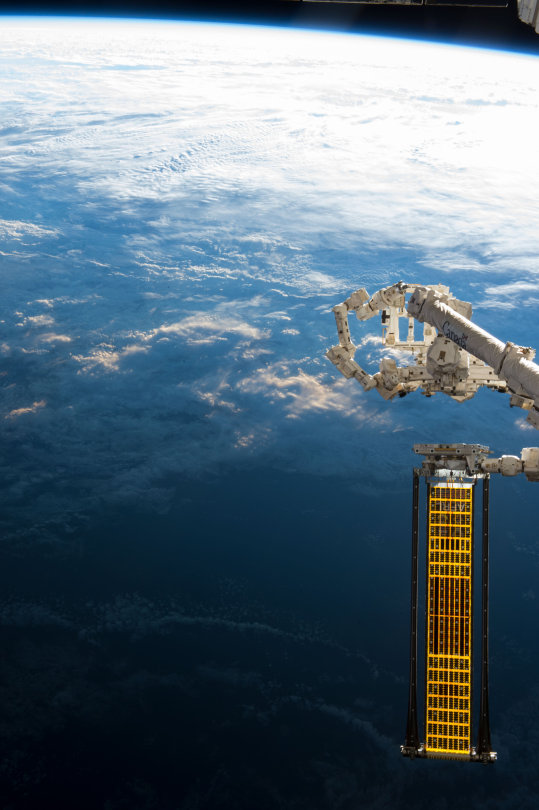
Cutting-edge experiments ride SpaceX's 26th CRS mission to space station SpaceX's 26th commercial resupply mission (CRS) is scheduled to launch to the International Space Station from NASA's Kennedy Space Center in Florida in late November. The Dragon spacecraft carries scientific experiments and technology demonstrations that explore growing plants in space, creating nutrients on-demand, in-space construction, and more. Here are details on some of the research launching to the space station: Big hopes for small tomatoes A continuous source of nutritious food is essential for long-duration exploration missions, and the typical pre-packaged astronaut diet may need to be supplemented by fresh foods produced in space. Researchers have been testing a plant growth unit on station known as Veggie and have successfully grown a variety of leafy greens. Veg-05, the next step in that work, focuses on growing dwarf tomatoes. "We are testing tomatoes, looking at the impacts of light spectrum on how well the crop grows, how delicious and nutritious the tomatoes are, and the microbial activity on the fruit and plants," says Gioia Massa, NASA Life Sciences project scientist and VEG-05 principal investigator. "We also are examining the overall effect of growing, tending, and eating crops on crew behavioral health. All of this will provide valuable data for future space exploration." Massa adds that tomatoes can be eaten fresh and are nutritious and widely consumed. Red Robin, the dwarf cherry tomato variety used in the investigation, grew well during ground testing and produced a large crop of nutritious and palatable fruit. Diagnoses on the fly Moon Microscope tests a kit for in-flight medical diagnosis that includes a portable hand-held microscope and a small self-contained blood sample staining device. An astronaut collects and stains a blood sample, obtains images with the microscope, and transmits images to the ground, where flight surgeons use them to diagnose illness and prescribe treatment. "We do not have a profound clinical problem on the space station, but crew members do experience changes in their immune systems," says NASA immunologist and principal investigator Brian Crucian. "During deep space missions, all stressors increase and our ability to care for the crew is reduced, a combination that could increase certain clinical risks. This project is designed to create a diagnostic laboratory capability that is highly miniaturized and compatible with microgravity and operational constraints. An ill crew member could perform the blood smear, imaging, and transmission of images in minutes." The kit could provide diagnostic capabilities for crew members in space or on the surface of the Moon or Mars, as well as the ability to test water, food, and surfaces for contamination. The hardware also may enable improved medical monitoring on upcoming Artemis and Gateway missions. Building bigger structures On Earth, gravity deforms large objects such as the beams used in large-scale construction. Microgravity enables fabrication of longer and thinner structures without this deformation. Extrusion demonstrates a technology using liquid resin to create shapes and forms that cannot be created on Earth. Photocurable resin is injected into pre-made flexible forms and a camera captures footage of the process. The capability for using these forms could enable in-space construction of structures such as space stations, solar arrays, and equipment. "This experiment leverages the microgravity environment to extrude both common and complex branching shapes," says principal investigator Ariel Ekblaw, director of the Massachusetts Institute of Technology Media Lab Space Exploration Initiative. "Our method reduces the time to produce key parts needed for daily mission use and it may support future space construction of large structures like trusses and antennae. The Extrusion investigation builds on our additive manufacturing and in-space self-assembly workstreams." The Space Exploration Initiative supports a range of microgravity and lunar research across science, engineering, art, and design. The experiment is packed inside a Nanoracks Black Box with several other experiments from the MIT Media Lab and is sponsored by the ISS National Lab. On-demand nutrients Supplying adequate nutrition is a major challenge to maintaining crew health on future long-duration space missions. Many vitamins, nutrients, and pharmaceuticals have limited shelf-life, and the ability to make such compounds on-demand could help maintain crew health and well-being. BioNutrients-2 tests a system for producing key nutrients from yogurt, a fermented milk product known as kefir, and a yeast-based beverage. The investigation kicks off phase two of the five-year BioNutrients program, headed by NASA's Ames Research Center and managed by Game Changing Development in NASA's Space Technology Mission Directorate. The program began with the launch of BioNutrients-1 in 2019. BioNutrients-2 employs a smaller system with a heated incubator that promotes growth of beneficial organisms. "This experiment adds follistatin, a protein therapeutic used to maintain muscle mass, as well as the fermented milk products yogurt and kefir," says principal investigator John Hogan of NASA Ames. "We also are testing a new lightweight bag system for effective microbial storage and growth in microgravity and evaluating our food safety techniques." For a third investigation, the researchers plan to engineer a single yeast strain to make up to four nutrient products. The researchers also are working to find efficient ways to use local resources to make bulk products such as plastics, construction binders, and feedstock chemicals. Such technologies are designed to reduce launch costs and increase self-sufficiency, extending the horizons of human exploration. Adding solar power Two roll-out solar arrays, or iROSAs, launched aboard SpaceX-22 and were installed in 2021. These solar panels, which roll out like a rug or a yoga mat using stored kinetic energy, expand the energy-production capabilities of the space station. The second set, launching in the trunk of SpaceX-26, provides a 20 to 30% increase in power for space station research and operations. "The first two arrays have been performing outstandingly well," says Matt Mickle, development projects senior manager at Boeing. "The solar cells are immensely more powerful than previous generations. We made minor modifications to the hardware for subsequent launches that improve operational efficiency." These arrays, the second of three packages, upgrade 50% of the station's power channels. Roll Out Solar Array technology was first tested on the space station in 2017. ROSA has been used on the NASA DART asteroid mission and is planned for use on the Gateway lunar outpost, a vital component of NASA's Artemis mission. The iROSA program provides a great example of using the space station as a proving ground for the technology and research needed to explore farther into space. Easing gravity transitions Travelers to space all face the transition from one gravity field to another. On future exploration missions, astronauts may encounter three different gravity fields: weightlessness while traveling in space, the gravity of another planet, and Earth's gravity when they return. These transitions can affect spatial orientation, head-eye and hand-eye coordination, balance, and locomotion and cause some crew members to experience space motion sickness. The Falcon Goggles hardware captures high-speed video of a subject's eyes, providing precise data on ocular alignment and balance. "These goggles could better inform our researchers of the impacts of microgravity on crew members and their ability to adapt and work in new gravities," said Dr. Cherie Oubre, deputy flight scientist with NASA's Human Research Program. "Devices like this will be invaluable as we work toward preparing astronauts for long-duration exploration missions to the Moon and beyond to Mars, and also can improve similar technologies here on Earth." TOP IMAGE....1 / 1This preflight image shows the Red Robin dwarf tomato used for Veg-05 growing in Veggie hardware at the Kennedy Space Center. Credit: NASA CENTRE IMAGE....Staining reagents and syringe storage box (upper left), staining device (lower left), and miniature microscope (right) for the Moon Microscope investigation. Credit: NASA JSC Immunology/Virology Laboratory LOWER IMAGE....Preflight image of BioNutrients-2 Yogurt Bags. The blue color of their contents comes from the pH Indicator, and the SABL interface board behind the bags provides a reference for the starting and ending colors. BioNutrients-2 tests a system for in-space production of nutrients from yogurt, kefir, and a yeast-based beverage. Credit: NASA Ames Research Center BOTTOM IMAGE....ROSA solar panels on the space station during earlier testing of deployment and retraction in 2017. A second set of iROSA panels launching in the trunk of SpaceX-26 could provide a 20 to 30% increase in power for space station research and operations. Credit: NASA
3 notes
·
View notes
Text
Mars
Space.com
NASA releases otherworldly footage of solar eclipse on Mars
The Mars moon Phobos, whose name means "Fear" in ancient Greek, was caught on camera by the NASA Perseverance rover on Feb. 8. The potato-shaped moon was visible in front of the sun from Percy's current perch in Jezero Crater.
Engineers from NASA's Jet Propulsion Laboratory (JPL) uploaded 68 images of the solar eclipse to their Perseverance raw images repository. The footage was filmed using the rovers left Mastcam-Z camera, one of two scouting imagers high on the neck-like mast of Perseverance often used to get sweeping landscape views of the Red Planet.
Phobos, first discovered by American astronomer Asaph Hall in 1877, is an asteroid-sized moon orbiting a few thousand miles (or kilometers) above the Martian surface and continuing to fall towards the planet. It should eventually break up due to the forces of the Red Planet's gravity.
Phobos and the other Mars moon, Deimos, have enigmatic formation histories: Scientists are not sure if they came from the asteroid belt, from collisions, from leftover debris from the early solar system or from some other scenario.
0 notes
Text
Explore the Surface of Mars in Spectacular 4K Resolution | Open Culture
1 note
·
View note
Link
NASA’s Spirit and Opportunity Mars rovers landed on the Red Planet on Jan. 3 and 24, 2004, respectively. This image shows a view Opportunity captured of its own shadow on July 26 of that year, the 180th Martian day, or sol, of its mission.NASA/JPL-Caltech This month marks the 20th anniversary of Spirit and Opportunity’s landing on Mars, part of a mission whose legacy will extend far into the future. In January 2004, twin NASA rovers named Spirit and Opportunity touched down on opposite sides of Mars, kicking off a new era of interplanetary robotic exploration. They arrived in dramatic fashion three weeks apart, each nestled in a cluster of airbags that bounced along the surface around 30 times before coming to a stop and deflating. The golf cart-size rovers’ mission: to look for evidence that water once flowed on the Red Planet’s surface. Their findings would rewrite science textbooks, including Opportunity’s discovery soon after landing of the famous “blueberries” – spherical pebbles of the mineral hematite that had formed in acidic water. Several years into the mission, Spirit, undaunted but now dragging a damaged wheel, uncovered signs of ancient hot springs that could have been ideal habitats for microbial life billions of years ago (if any ever existed on the Red Planet). Scientists suspected Mars had long ago been radically different than the freezing desert it is today: Orbital images had shown what looked like networks of water-carved channels. But before Spirit and Opportunity, there was no proof that liquid water had formed those features. On the 20th anniversary of the landing of Spirit and Opportunity, celebrate NASA’s Mars Exploration Rover Project with this two-sided poster that lists some of the pioneering explorers’ accomplishments on the Red Planet.NASA/JPL-Caltech Download a free poster celebrating the 20th anniversary of the landings “Our twin rovers were the first to prove a wet, early Mars once existed,” said former project scientist Matt Golombek of NASA’s Jet Propulsion Laboratory in Southern California, which managed the Mars Exploration Rover mission. “They paved the way for learning even more about the Red Planet’s past with larger rovers like Curiosity and Perseverance.” An Enduring Legacy Thanks in part to the science collected by Spirit and Opportunity, NASA approved development of the SUV-size Curiosity rover to investigate whether the chemical ingredients that support life were present billions of years ago on what was once a watery world. (The rover found soon after its 2012 landing that they were.) Perseverance, which arrived at the Red Planet in 2021, is building on Curiosity’s success by collecting rock cores that could be brought to Earth to check for signs of ancient microbial life through the Mars Sample Return campaign, a joint effort by NASA and ESA (European Space Agency). While working on Spirit and Opportunity, engineers developed practices for exploring the surface that continue today, including the use of specialized software and 3D goggles to better navigate the Martian environment. And after honing years of expertise during the twin rovers’ travels over Mars’ rocky, sandy surface, engineers are able to plan safer, longer drives, and to quickly put together the far more complex daily plans required to operate Curiosity and Perseverance. Using footage filmed at JPL when Spirit touched down on Jan. 3, 2004, as well an animation depicting the rover’s arrival at the Red Planet, this video celebrates the 20th anniversary of Mars Exploration Rover Project landings. Spirit’s twin Opportunity arrived at Mars three weeks later. Credit: NASA/JPL-Caltech Science team members have also become more adept in their role as virtual field geologists, drawing on years of knowledge to select the best ways to investigate Martian terrain using the robotic “eyes” and tools carried by their roving partners. Martian Marathon Designed to last just 90 days, Spirit landed on Jan. 3; Opportunity, on Jan. 24. The solar-powered Mars Exploration Rovers soldiered on for years – in the case of Opportunity, nearly 15 years, before succumbing to a planet-enveloping dust storm in 2018. That durability surpassed the wildest dreams of scientists and engineers, who had only expected localized exploration over a distance of no more than one-third of a mile (600 meters). Instead, through their long-lived robotic surrogates, the team got the chance to roam a wide variety of Martian terrains. Opportunity, the first rover to go a marathon-length distance on another planet, would ultimately cover nearly 30 miles (45 kilometers) in total – the farthest distance driven on another planet. “This was a paradigm shift no one was expecting,” said former project manager John Callas of JPL. “The distance and time scale we covered were a leap in scope that is truly historic.” This artist’s concept depicts one of NASA’s Mars Exploration Rovers on the Red Planet. The twin rovers, Spirit and Opportunity, landed in 2004 and lasted years beyond their expected 90-day mission.NASA/JPL-Caltech The chance to see so much was critical for revealing that not only was Mars once a wetter world, but also that it supported many different kinds of watery environments – fresh water, hot springs, acidic and salty pools – at distinct points in its history. Continuing Inspiration The roving twins would also inspire a new generation of scientists. One of those was Abigail Fraeman, who was a high school student invited to JPL on the night of Opportunity’s landing. She got to watch the excitement as the first signal returned, confirming Opportunity had safely landed. She would go on to pursue a career as a Mars geologist, returning to JPL years later to help lead Opportunity’s science team. Now deputy project scientist for Curiosity, Fraeman calls many of the people she met on Opportunity’s landing night her close colleagues. “The people who kept our twin rovers running for all those years are an extraordinary group, and it’s remarkable how many have made exploring Mars their career,” Fraeman said. “I feel so lucky I get to work with them every day while we continue to venture into places no human has ever seen in our attempt to answer some of the biggest questions.” More About the Mission JPL, a division of Caltech in Pasadena, California, managed the Mars Exploration Rover Project for NASA’s Science Mission Directorate in Washington. For more information about Spirit and Opportunity, visit: https://mars.nasa.gov/mer News Media Contacts Andrew GoodJet Propulsion Laboratory, Pasadena, [email protected] Karen Fox / Alana JohnsonNASA Headquarters, Washington301-286-6284 / [email protected] / [email protected] 2024-003 Share Details Last Updated Jan 17, 2024 Related TermsMars Exploration Rovers (MER)Jet Propulsion LaboratoryMarsMars Exploration ProgramOpportunity (Rover)Spirit (Rover) Explore More 5 min read NASA Study: More Greenland Ice Lost Than Previously Estimated Article 1 hour ago 7 min read Michael Thorpe Studies Sediment from Source to Sink Sedimentary and planetary geologist Michael Thorpe finds the stories rocks have to tell, those on… Article 1 hour ago 6 min read This US-Indian Satellite Will Monitor Earth’s Changing Frozen Regions Article 7 days ago
0 notes
Link
This time the helicopter covered 411 meters above the Martian desert The American Aeronautics and Space Administration NASA announced that the Ingenuity helicopter made a new flight to Mars. On October 27, 2023, the 64th flight of the device took place. [caption id="attachment_79365" align="aligncenter" width="780"] NASA's[/caption] This time the helicopter covered 411 meters above the Martian desert. During the flight, filming was carried out using a navigation camera. [caption id="attachment_79366" align="aligncenter" width="780"] NASA's[/caption] NASA's Ingenuity Martian helicopter captured and transmitted truly fantastic footage to Earth: video With the bright sun overhead, the ship cast shadows on the planet's surface, resulting in some truly "sci-fi" footage. As NASA explained, the camera is “mounted on the fuselage of the helicopter and pointed straight down to track the surface during flight.” [caption id="attachment_79368" align="aligncenter" width="780"] NASA's[/caption] The mission team then combined the footage and came up with one impressive video: https://youtu.be/qzJxHAZQIlg Recall that the Ingenuity helicopter was delivered to Mars attached to the bottom of the Perseverance rover, which landed in the Jezero Crater on February 18, 2021. Ingenuity's main goals include demonstrating technology, conducting the first flights to Mars, and conducting exploration for Perseverance.
#astronaut#Earth_science#International_Space_Station_ISS#Mars_exploration#NASA#NASA_projects#National_Aeronautics_and_Space_Administration#space_agency#space_exploration#space_missions#space_research#space_technology
0 notes
Text
Footage from another planet..
#mars portal#art#beauty#photography#vintage#black and white#60s style#the paradigm web#painting#abstraction#nude figure
0 notes
Text




[HV] NASA’s Mars rover captures stunning footage! Ancient fossils, bones of aliens?
The solar system is full of interesting and mysterious attractions, and one of the most curious planets for scientists today is undoubtedly Mars. Mars is a planet different from Earth that scientists believe may be the earliest planet to exist life.
Since the probes launched by NASA of the US in succession to land on Mars, they have brought humans a large amount of image and situation data on the Martian surface, scientists have discovered. showing signs of life. For example, there are clear traces of water currents on Mars, water ice at the north and south poles of Mars, and the possible existence of lakes on Mars.
All of these findings seem to suggest to scientists that life on Mars is very likely. In the photos sent back from NASA’s Mars rover “Curiosity” not long ago, some extremely strange objects have been discovered.
NASA’s Curiosity probe sent back a photo of the Gale Crater crater on Mars with an object like a dinosaur bone fossil, half buried on a large rock.
From a structural perspective, it is completely similar to the dinosaurs that once existed on earth, whether in the arrangement of the bones or the shape of the skull. In this regard, many astronomy enthusiasts have speculated that paleontological fossils discovered on Mars this time can certainly prove that Mars once had life forms in distant antiquity. . Some experts have also expressed that the appearance of this object could prove that the earth, Mars and even the entire solar system share a common origin of life.
Before the information of the foreign press, the existence of creatures on Mars has always been a mystery that scientists want to solve. Not long ago, a foreign UFO explorer found a “skeleton” of suspected aliens in a photo taken by NASA’s “Curiosity” rover on Mars earlier, this made fans If they believe in the existence of extraterrestrial life, they are extremely interested.
The photos show two white, skeleton-shaped objects exposed to the Martian dust, one of which has the suspected shape of a head, torso and arms, while the other “skeleton” has dimensions. less. Some netizens called the unidentified object a “backbone”, while others suggested it was a fossil of some kind of creature. But NASA has not yet commented on the images of these two irregular shapes.
However, former NASA chief scientist Alan Stoffan said she believes there have been “clear signs” of extraterrestrial life for more than a decade, but it will take another 20 to 30 years for solid evidence. sure.
UFO explorers who discovered suspected alien “skeletons” say they have previously found a range of life forms in Mars photographs. However, NASA refuses to acknowledge their existence. UFO explorers also claim that we’ve found images of lizards and rats on Mars, so the skeleton-shaped white object is not a surprising object. One needs to remember that it is these details that paint the big picture.
Fossil of a dinosaur skull
Photos posted by UFO explorers on Facebook show that in many Mars exploration photos released by NASA, many strange objects have been found that have not been naturally formed, even people have found including fossils of ancient Martian creatures.
They say this is evidence of an ancient Jurassic creature found millions of years ago on Mars, and this time the clearest and most visible example of dinosaur fossil bones found on the red planet. .
NASA wants to put humans on Mars?
In fact, the strange things found on Mars are much more than that, so whether life on Mars exists or not can only be known after landing on Mars.
In recent years, scientists have sent many submersibles to Mars, hoping to use it to determine if there is life on the red planet.
At the same time, we also hope to get detailed information about the climate, geology of this distant planet, and most importantly, to prepare for the human landing on Mars…
#question everything#ancient#ancestors#mars#alien dna#alien technology#fossils#nasa#space#outer space
1 note
·
View note
Text
MARS Spacial 🧡🧡🧡
Perseverance captures video of solar eclipse on Mars
NASA’s Perseverance Mars rover has captured dramatic footage of Phobos, Mars’ potato-shaped moon, crossing the face of the Sun. These observations can help scientists better understand the moon’s orbit and how its gravity pulls on the Martian surface, ultimately shaping the Red Planet’s crust and mantle.Captured with Perseverance’s…

View On WordPress
0 notes
Text
NASA's Perseverance rover captures video of solar eclipse on Mars
NASA’s Perseverance rover captures video of solar eclipse on Mars
NASA’s Perseverance Mars rover has captured dramatic footage of Phobos, Mars’ potato-shaped moon, crossing the face of the Sun. These observations can help scientists better understand the moon’s orbit and how its gravity pulls on the Martian surface, ultimately shaping the Red Planet’s crust and mantle.
View On WordPress
0 notes
Video
youtube
NASA’s Perseverance Rover Captures Video of Solar Eclipse on Mars The Mastcam-Z camera recorded video of Phobos, one of the Red Planet’s two moons, to study how its orbit is changing over time. NASA’s Perseverance Mars rover has captured dramatic footage of Phobos, Mars’ potato-shaped moon, crossing the face of the Sun. These observations can help scientists better understand the moon’s orbit and how its gravity pulls on the Martian surface, ultimately shaping the Red Planet’s crust and mantle. Captured with Perseverance’s next-generation Mastcam-Z camera on April 2, the 397th Martian day, or sol, of the mission, the eclipse lasted a little over 40 seconds – much shorter than a typical solar eclipse involving Earth’s Moon. (Phobos is about 157 times smaller than Earth’s Moon. Mars’ other moon, Deimos, is even smaller.) The images are the latest in a long history of NASA spacecraft capturing solar eclipses on Mars. Back in 2004, the twin NASA rovers Spirit and Opportunity took the first time-lapse photos of Phobos during a solar eclipse. Curiosity continued the trend with videos shot by its Mastcam camera system. But Perseverance, which landed in February 2021, has provided the most zoomed-in video of a Phobos solar eclipse yet – and at the highest-frame rate ever. That’s thanks to Perseverance’s next-generation Mastcam-Z camera system, a zoomable upgrade from Curiosity’s Mastcam. “I knew it was going to be good, but I didn’t expect it to be this amazing,” said Rachel Howson of Malin Space Science Systems in San Diego, one of the Mastcam-Z team members who operates the camera. Howson noted that although Perseverance first sends lower-resolution thumbnails that offer a glimpse of the images to come, she was stunned by the full-resolution versions: “It feels like a birthday or holiday when they arrive. You know what’s coming, but there is still an element of surprise when you get to see the final product.” Color also sets this version of a Phobos solar eclipse apart. Mastcam-Z has a solar filter that acts like sunglasses to reduce light intensity. “You can see details in the shape of Phobos’ shadow, like ridges and bumps on the moon’s landscape,” said Mark Lemmon, a planetary astronomer with the Space Science Institute in Boulder, Colorado, who has orchestrated most of the Phobos observations by Mars rovers. “You can also see sunspots. And it’s cool that you can see this eclipse exactly as the rover saw it from Mars.” As Phobos circles Mars, its gravity exerts small tidal forces on the Red Planet’s interior, slightly deforming rock in the planet’s crust and mantle. These forces also slowly change Phobos’ orbit. As a result, geophysicists can use those changes to better understand how pliable the interior of Mars is, revealing more about the materials within the crust and mantle. Scientists already know that Phobos is doomed: The moon is getting closer to the Martian surface and is destined to crash into the planet in tens of millions of years. But eclipse observations from the surface of Mars over the last two decades have also allowed scientists to refine their understanding of Phobos’ slow death spiral. More About the Mission A key objective for Perseverance’s mission on Mars is astrobiology, including the search for signs of ancient microbial life. The rover will characterize the planet’s geology and past climate, pave the way for human exploration of the Red Planet, and be the first mission to collect and cache Martian rock and regolith (broken rock and dust). Subsequent NASA missions, in cooperation with ESA (European Space Agency), would send spacecraft to Mars to collect these sealed samples from the surface and return them to Earth for in-depth analysis. The Mars 2020 Perseverance mission is part of NASA’s Moon to Mars exploration approach, which includes Artemis missions to the Moon that will help prepare for human exploration of the Red Planet. NASA’s Jet Propulsion Laboratory, which is managed for the agency by Caltech in Pasadena, California, built and manages operations of the Perseverance rover. Arizona State University leads the operations of the Mastcam-Z instrument, working in collaboration with Malin Space Science Systems in San Diego.
3 notes
·
View notes
Video
youtube
Check out this incredible video of the entry, descent and landing of the Mars Perseverance Rover on February 18th. The footage begins about 7 miles (11 km) above the planet’s surface and ends with the rover’s touchdown in Mars’ Jezero Crater. For the next Martian year (about 687 Earth days), the Perseverance Rover will search for signs of ancient life and collect rock and soil samples to bring back to Earth. Who wants to see more images of Mars in the coming months?
Video source: NASA
215 notes
·
View notes
Photo

HERE’S WHAT YOU MISSED THIS WEEK (2.17-2.23.21):
NEW MUSIC:
RedHook announced the details of their debut EP Bad Decisions, as well as released its title track. The highly-anticipated release is scheduled to drop on April 23.
Green Day released a new song titled “Here Comes The Shock,” their first new original material in just over a year. Fans caught a first glimpse of the song during the NHL Outdoors event this past Saturday.
Mike Shinoda of Linkin Park released a new single titled “Happy Endings,” featuring Iann Dior and UPSAHL. The trio later caught up by chatting on the former artist’s Twitch channel.
Senses Fail released a scathing new track titled “Lush Rimbaugh,” their first new music since 2018. The release follows a split Misfits covers EP with Saves the Day called Through Being Ghoul.
Chase Atlantic shared another song from their upcoming album Beauty in Death titled “Empty.” The album, which features the previous single “Slide,” is set for release on March 5 via Fearless Records.
Along with the release of his new album Trauma Factory, nothing,nowhere. dropped a new music video for the song “Upside Down.” The video follows a short documentary about the process of assembling the record.
Health released a remix of Rise Against’s new track “Broken Dreams, Inc.” The song was originally recorded for the soundtrack of DC's Dark Nights: Death Metal series.
TOUR ANNOUNCEMENTS:
You Me at Six released footage of them playing their track “Glasgow” live from Abbey Studios with the Wired Strings Orchestra. The album of which the song is off of, Suckapunch, is out now via Underdog/AWAL Records.
Evanescence made an appearance on Jimmy Kimmel Live!, performing their new song “Wasted on You.” The band is gearing up to release their album The Bitter Truth on March 26.
Funeral for a Friend have rescheduled their upcoming UK shows to 2022. Kicking off in Cardiff and ending in London, the tour will have the band playing tracks from their first three albums.
OTHER NEWS:
Yungblud's version of the David Bowie track “Life on Mars” was played as the rover Perseverance touched down on the surface. The song had been offered to NASA by the late singer’s estate.
The Pretty Reckless’ new album Death by Rock and Roll debuted at No. 6 on the UK Albums Chart. The record was also the most downloaded album in the country over the course of its first weekend out in the world.
___
Check in next Tuesday for more “Posi Talk with Sage Haley,” only at @sagehaleyofficial!
#sage haley#posi talk#redhook#green day#mike shinoda#senses fail#chase atlantic#nothing nowhere#rise against#you me at six#evanescence#funeral for a friend#yungblud#the pretty reckless
19 notes
·
View notes
Text
Tiny NASA Cameras to Watch Commercial Lander form Craters on Moon
youtube
Footage from vibration and thermal vacuum testing of the SCALPSS cameras and data storage unit.
Credits: NASA/Gary Banziger
This little black camera looks like something out of a spy movie — the kind of device one might use to snap discrete photos of confidential documents.
It's about half the size of a computer mouse.
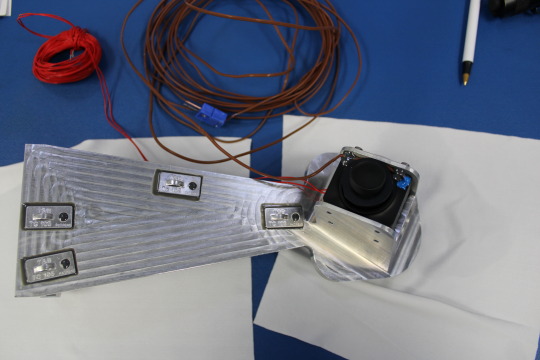
The SCALPSS cameras, one of which is pictured here prior to thermal vacuum testing, are about the size of a computer mouse. Credits: NASA
But the only spying this camera — four of them, actually — will do is for NASA researchers wondering what happens under a spacecraft as it lands on the Moon.
It's a tiny technology with a big name — Stereo Camera for Lunar Plume-Surface Studies, or SCALPSS for short — and it will journey to the Moon in 2021 as a payload aboard an Intuitive Machines Nova-C lunar lander spacecraft. Intuitive Machines is one of two U.S. companies delivering technology and science experiments to the lunar surface later this year as part of NASA's Commercial Lunar Payload Services (CLPS) initiative. SCALPSS will provide important data about the crater formed by the rocket plume of the lander as it makes its final descent and landing on the Moon's surface.
As part of the Artemis program, NASA will send robots and humans to study more of the Moon than ever before. The agency plans to establish sustainable lunar exploration by the end of the decade, and has outlined its Artemis Base Camp concept for the lunar South Pole. Landers may deliver multiple payloads very near one another. Data such as that from SCALPSS will prove aid in computer models that inform subsequent landings.
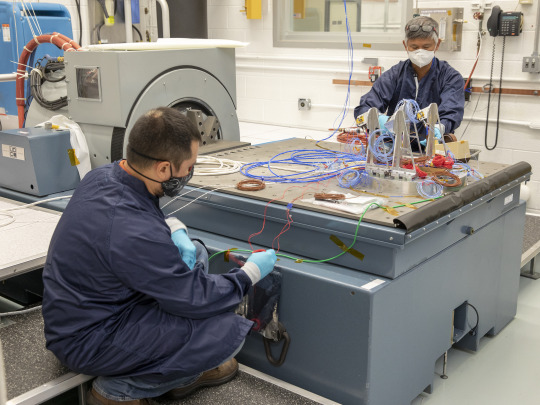
SCALPSS team members prepare the cameras and data storage unit for vibration testing. Credits: NASA/David C. Bowman
"As we send bigger, heavier payloads and we try to land things in close proximity to each other, first at the Moon then at Mars, this ability to predict landing impacts is very important," said Michelle Munk, principal investigator for SCALPSS at NASA's Langley Research Center in Hampton, Virginia.
The four SCALPSS cameras, which will be placed around the base of the commercial lander, will begin monitoring crater formation from the precise moment a lander's hot engine plume begins to interact with the Moon's surface.
"If you don't see the crater when it starts to form, you can't really model it," said Munk. "You've got to have the start point and the end point and then you can figure out what happened, in between."
The cameras will continue capturing images until after the landing is complete. Those final stereo images, which will be stored on a small onboard data storage unit before being sent to the lander for downlink back to Earth, will allow researchers to reconstruct the crater's ultimate shape and volume.

The SCALPSS data storage unit will store the imagery the cameras collect as the Intuitive Machines Nova-C lunar lander spacecraft makes its final descent and lands on the Moon's surface. Credits: NASA
Testing to characterize the SCALPSS camera and lens took place last year at NASA's Marshall Space Flight Center in Huntsville, Alabama. Researchers conducted radial distortion, field-of-view and depth-of-focus tests among others. They also ran analytical models to better characterize how the cameras will perform. Development of the actual SCALPSS payload took place at Langley. And over the summer, researchers were able to enter the lab to assemble the payload and conduct thermal vacuum and vibration tests.
That lab access involves special approval from officials at Langley, which is currently only giving access to essential employees and high-priority projects to keep employees safe during the ongoing COVID-19 pandemic. SCALPSS was one of the first projects to return to the center. Before they could do that, facilities had to pass safety and hazard assessments. And while on center, the team had to follow strict COVID-19 safety measures, such as wearing masks and limiting the number of people who could be in a room at one time. The center also provided ample access to personal protective equipment and hand sanitizer.
The SCALPSS hardware was completed in late October and will be delivered to Intuitive Machines in February.
"Development and testing for the project moved at a pretty brisk pace with very limited funds," said Robert Maddock, SCALPSS project manager. "This was likely one of the most challenging projects anyone on the team has ever worked on."
But Munk, Maddock and the entire project team have embraced these challenges because they know the images these little cameras collect may have big ripple effects as NASA prepares for a human return to the Moon as part of the Artemis program.
"To be able to get flight data and update models and influence other designs — it's really motivating and rewarding," said Munk.
Hot off the heels of this project, the SCALPSS team has already begun development of a second payload called SCALPSS 1.1. It will be flown by another CLPS commercial lander provider to a non-polar region of the Moon in 2023 and collect data similar to its predecessor. It will also carry two additional cameras to get higher resolution stereo images of the landing area before engine plume interactions begin, which is critical for the analytic models in establishing the initial conditions for the interactions.
NASA’s Artemis program includes sending a suite of new science instruments and technology demonstrations to study the Moon, landing the first woman and next man on the lunar surface in 2024, and establishing a sustained presence by the end of the decade. The agency will leverage its Artemis experience and technologies to prepare for humanity’s the next giant leap – sending astronauts to Mars as early as the 2030s.
Joe Atkinson
NASA Langley Research Center
10 notes
·
View notes